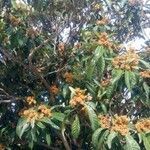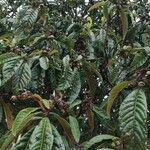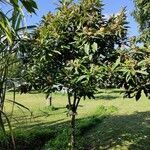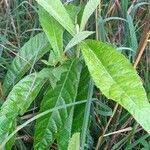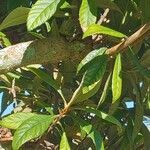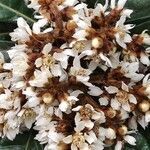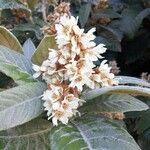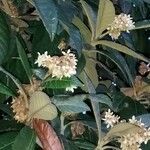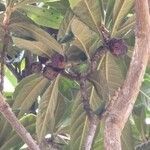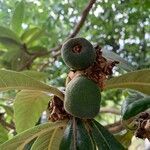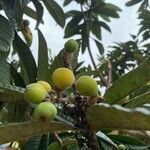Tree up to 8 m high when mature; trunk well developed; primary stems erect; secondary stems spreading; young stems stout, white-tomentose; older stems with prominent lf scars, becoming greyish brown and transversely calloused. Lvs near branch tips; petiole c. 15 mm long, stout; blade oblanceolate to narrowly elliptic, 150-350-(400) × 75-100-(130) mm, acute, tapering to cuneate or slightly auriculate base, very coriaceous, ± rugose, dark green and glossy above, thinly grey-or brown-tomentose below (very young lvs completely brown-tomentose), serrate at least in upper 1/2 (sometimes obscurely); stipules long-triangular, ± attenuate, pilose. Infl. of many fls; pedicels 5-8 mm long, brownish tomentose. Sepals fused for most of length; lobes 2-4 mm long, brown-tomentose. Petals white or ivory, oblong, c. 7-8 × 3-4 mm, shallowly emarginate. Fr. pyriform to broadly ellipsoid-oblong or subglobose, up to 50 × 35 mm; skin yellow, ± tomentose; flesh sweet.
Small trees. Twigs rather stout, rough. Leaves more or less crowded at twig ends, oblong to lanceolate, 12-28 by 3.5-8 cm, margin shordy dentate in upper part, coriaceous, with 10-22 pairs of nerves, woolly above when very young but soon glabrate, densely woolly and tardily glabrescent below. Petiole 4-10 mm long. Stipules intrapetio-lar, cohering or connate into a 2-topped scale, up to 1 cm long. Inflorescence a compound raceme, 15-20 cm long, peduncle short, pedicels very short. Flowers rather large, very hairy. Sepals persistent. Petals long remaining, white. Ovary inferior or almost so, the densely hairy top free from the hypanthium, 5-celled, styles (practically) free, hairy at base. Fruits globular to ovoid, up to 8 cm diam. but usually (much) smaller, exocarp hairy, yellow to orange, mesocarp juicy, endocarps mem-branous. Seeds 2 or 3, large, with firm, glabrous, brown testa.
A small evergreen tree up to 6-10 m high. It has a round crown. Leaves are large and strongly ribbed. They are 12-30 cm long and 8-10 cm wide. They are dark green and glossy on the upper surface and woolly white underneath. They are leathery with slight teeth. The new growth is tinged with red. Flowers have a strong scent. Flowers are small and white and in clusters at the ends of branches. They have a scent. Fruit are in loose clusters of about 10. They are pear shaped. They are 3-5 cm long and yellow when ripe. There are 3-5 large brown seeds in each fruit.
Stems: bark ± smooth. Leaves: petiole 6–10 mm; blade margins dentate in distal 1/2, lateral veins 15–25 per side, apex acute. Inflorescences: branches stiff, densely rufous-tomentose, with 1–3 barely reduced leaflike bracts, flowers ± sessile; bracteoles deciduous, narrowly triangular, margins entire, rufous-tomentose. Flowers: sepals 3 × 3 mm; petals ± spreading, often notched, 8–10 mm. Pomes: flesh sweet. Seeds 3–5, black, ovoid, shiny. 2n = 34.
